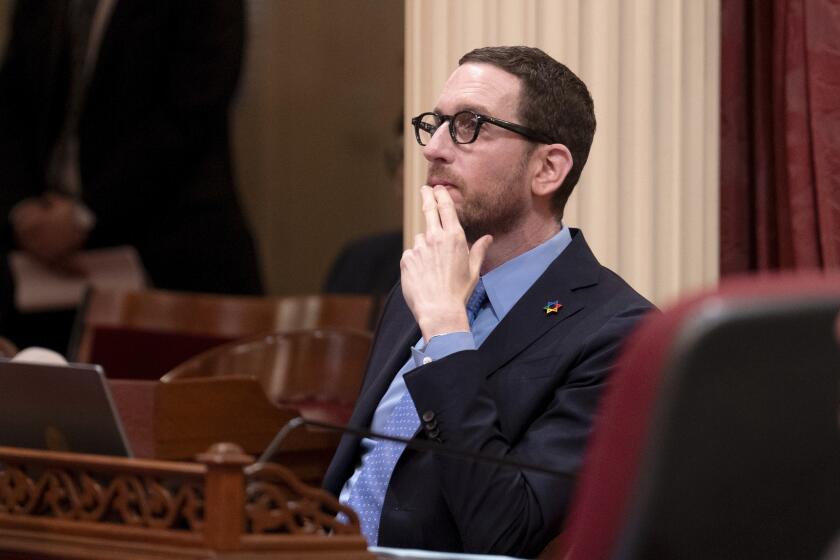Op-Ed: What do you call 7 lbs. of campaign mail for 3 voters?
We’re conscientious voters in my household, never missing a chance to cast a ballot. And that’s probably why, in the final weeks before elections, we find our mailbox flooded with a tsunami of political advertisements. In the recent primary, for example, nearly 200 pieces of mail showed up for my wife, my daughter and me, with 29 of them arriving on the Monday before the election, long after we had made up our minds and voted by mail.
We got 19 mailers in the race to replace County Supervisor Zev Yaroslavsky, 16 of them from a single candidate. In the race for the state Senate seat that Ted Lieu vacated to run for Congress, 70 pieces of mail came. Fifty-five mailers came from those hoping to replace retiring Congressman Henry A. Waxman, 43 of them on behalf of candidates who didn’t make it into the runoff. And there were 25 so-called slate mailers laying out a list of candidates we should vote for, most of whom (if you read the fine print) had paid to be included on the slate.
As a voter, I was annoyed by the 7 pounds of mail we received — seriously, I weighed it. But as a campaign strategist who for several decades has run or advised dozens of campaigns, I understood the impulse behind the mailings.
Still, the experience left me with a question: Does this kind of deluge actually get results?
It’s easy to see why campaigns like mail. Anyone hoping to get elected to office has to do two things: introduce himself to voters in a persuasive way (hence the mailers with beaming candidates surrounded by loving admirers) and convince voters that the alternative is terrible (which accounts for the mailers blasting the opposition).
The ideal way for a candidate to introduce himself is in person, through such things as walking precincts, hosting town hall meetings and participating in candidate forums. That might work if you’re running for City Council in, say, Ridgecrest, but it’s physically impossible in a city the size of Los Angeles or in a California congressional district with about 700,000 residents.
Mail is a fairly cheap way (compared with television advertising) for candidates to take their message directly to voters. And unlike television, which goes to all homes regardless of whether the people living there are voters, it allows campaigns to tailor specific messages to specific constituents. Mail can be targeted based on measures such as partisan preference, gender, age, frequency of voting and, within a certain margin of error, ethnicity and sexual preference.
But as appealing as mail can appear to campaigns, and as heavily as they rely on it, the research about whether it works is decidedly mixed.
A team of professors at Stanford, the University of Pennsylvania and Yale looked at the impact of a six-piece mailing program in the 2006 contest for Kansas attorney general and found that the mailings had a statistically and politically significant effect on the candidate’s share of the vote. They concluded that a 10% increase in the amount of mail sent to a precinct increased the candidate’s vote share by roughly 3 percentage points.
A Yale research project found that turnout was increased substantially by personal canvassing, slightly by direct mail and not at all by telephone calls. But randomized field experiments in Connecticut and New Jersey reported on in the journal Electoral Studies found that campaign mail does little to turn out voters and that negative mail may even dampen turnout.
A 2007 Canadian study concluded that, “despite its ubiquity, direct mail had minimal and probably negative persuasive effects.” But an Ohio State researcher found that negative direct mail improved turnout by about 6%.
So what’s a campaign consultant going to do with all that conflicting research? Head for the post office.
Campaigns will continue to rely on mail because they always have, and because it isn’t clear that they have a better option. Moreover, many consultants charge commissions on each piece of mail sent, which is another reason they like it.
In the end, my family received 7 pounds of mail because the campaigns knew we were going to vote, and they didn’t have any other way of making sure their message got into our house. Given that neither of those things is likely to change in the near future, we just have to hope that our mail carrier has a strong back.
Darry Sragow is a campaign strategist and managing partner of Dentons’ Los Angeles office.
More to Read
A cure for the common opinion
Get thought-provoking perspectives with our weekly newsletter.
You may occasionally receive promotional content from the Los Angeles Times.










